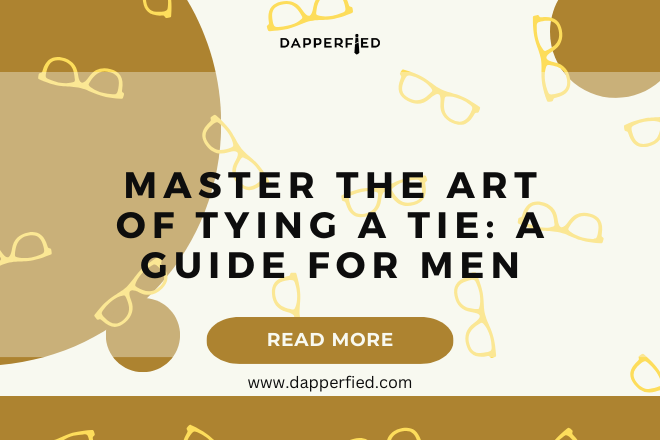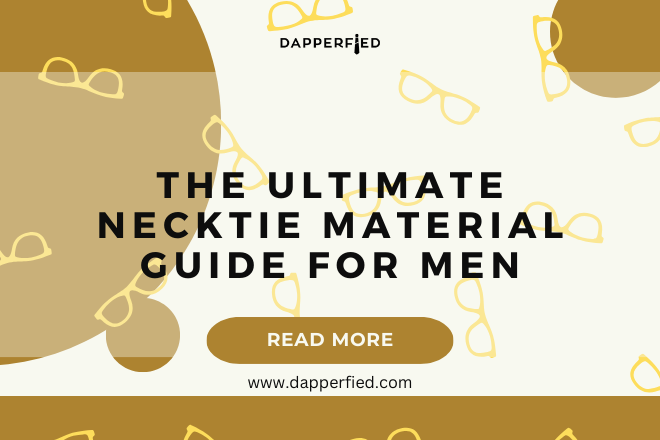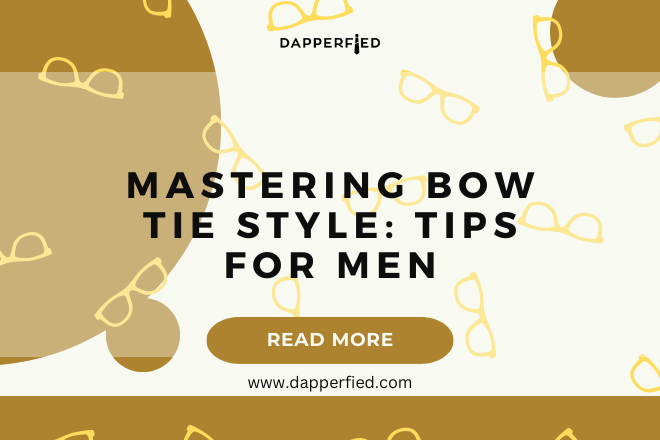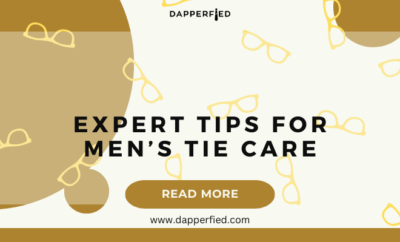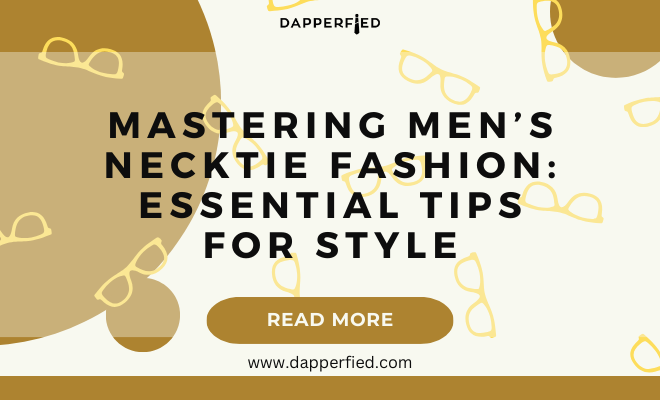
Men's Style
Mastering Men’s Necktie Fashion: Essential Tips for Style
When it comes to necktie materials and fabrics, there are a wide variety of options to choose from. Silk is the most popular choice for neckties due to its luxurious look and feel. It is a natural fiber that is known for its lustrous appearance and smooth texture. Silk ties are versatile and can be worn for both formal and casual occasions. Another popular material for neckties is polyester, which is a synthetic fiber known for its durability and affordability. Polyester ties are often chosen for their low maintenance and wrinkle-resistant properties, making them a practical choice for everyday wear. Other common materials for neckties include wool, cotton, and linen, each with their own unique characteristics and benefits.
In addition to the material, the weave of the fabric also plays a significant role in the appearance and texture of a necktie. A plain weave, also known as a flat weave, is the most common type of weave for neckties. It is characterized by a smooth and even texture, making it a versatile option for various styles and patterns. Another popular weave for neckties is the twill weave, which is known for its diagonal rib pattern. Twill ties have a subtle texture and a luxurious drape, making them an elegant choice for formal occasions. Other types of weaves include satin, jacquard, and herringbone, each offering a unique look and feel to suit different preferences and styles.
Key Takeaways
- Silk, wool, and cotton are common materials for neckties, each with its own unique texture and appearance.
- The width of a necktie should complement the width of the suit lapels, and the length should reach the belt buckle.
- When matching neckties with shirts and suits, consider color coordination and contrast to create a polished look.
- Different necktie knots, such as the Windsor or Four-in-Hand, can be chosen based on the formality of the occasion.
- Incorporate patterns and colors into necktie fashion to add personality and style to your outfit.
- To maintain and care for your neckties, store them properly and spot clean any stains promptly.
- Explore creative ways to wear neckties, such as the casual loose knot or the trendy necktie as a belt, for a modern and stylish look.
Choosing the Right Necktie Width and Length
When it comes to choosing the right necktie width and length, it’s important to consider your body type and personal style. The standard width for a necktie is around 3 to 3.5 inches, which is considered a versatile and classic option that suits most men. However, if you have a broader build or prefer a more modern look, you may opt for a wider tie ranging from 3.75 to 4 inches. On the other hand, if you have a slim build or prefer a more traditional look, a narrower tie ranging from 2.5 to 3 inches may be more suitable. Ultimately, the width of the tie should complement the width of your lapels and the overall proportions of your outfit.
In terms of length, a standard necktie is typically around 57 to 58 inches long, which is suitable for most men of average height. However, if you are particularly tall or have a larger neck size, you may require a longer tie ranging from 60 to 63 inches. Conversely, if you are on the shorter side or have a smaller neck size, a shorter tie ranging from 54 to 56 inches may be more appropriate. It’s important to ensure that the tip of the tie reaches the top of your belt buckle when tied, with the right length allowing for a balanced and polished look. Ultimately, choosing the right width and length of a necktie is about finding the right proportions that complement your body type and personal style.
Matching Neckties with Shirts and Suits
Matching neckties with shirts and suits is an essential skill for creating a polished and cohesive look. When it comes to pairing a tie with a shirt, it’s important to consider both color and pattern coordination. A solid color tie is a versatile option that can be paired with almost any shirt, making it a timeless choice for various occasions. When matching a solid tie with a patterned shirt, it’s best to choose a tie color that complements one of the colors in the shirt’s pattern. For example, if you’re wearing a striped shirt with blue and white stripes, you can opt for a solid blue tie to create a harmonious look.
When it comes to pairing a tie with a suit, it’s important to consider both the color and texture of the suit fabric. A classic combination is pairing a solid color tie with a patterned suit or vice versa to create visual interest without overwhelming the overall look. For example, if you’re wearing a pinstripe suit, you can pair it with a solid color tie in a complementary shade to create a balanced ensemble. Additionally, considering the formality of the occasion is important when choosing tie colors and patterns. For formal events, such as weddings or business meetings, it’s best to opt for classic colors like navy, burgundy, or black, while for more casual settings, you can experiment with bolder colors and patterns to showcase your personal style.
Tying Different Necktie Knots for Various Occasions
| Necktie Knot | Occasion | Difficulty |
|---|---|---|
| Four-in-Hand | Everyday, Casual | Easy |
| Half Windsor | Business, Semi-formal | Medium |
| Full Windsor | Formal, Interviews | Hard |
| Pratt (Shelby) Knot | Work, Meetings | Medium |
Tying different necktie knots can add personality and flair to your outfit while also serving practical purposes based on the occasion. The four-in-hand knot is one of the most popular and versatile tie knots due to its simplicity and asymmetrical shape. It is suitable for both casual and formal occasions and pairs well with most collar types. The half-Windsor knot is another classic option that is slightly larger than the four-in-hand knot, making it suitable for wider collar spreads and formal events. It is characterized by its triangular shape and balanced appearance, making it a timeless choice for business settings.
For more formal occasions or when wearing shirts with wide collar spreads, the Windsor knot is an ideal choice due to its symmetrical and substantial shape. It is best paired with wide-collar shirts and creates a polished look that exudes confidence and sophistication. The Pratt knot, also known as the Shelby knot, is another versatile option that is slightly asymmetrical and medium in size, making it suitable for most collar types and occasions. Ultimately, choosing the right tie knot depends on the collar type of your shirt, the formality of the occasion, and your personal style preferences.
Incorporating Patterns and Colors into Necktie Fashion
Incorporating patterns and colors into necktie fashion allows you to showcase your personal style while adding visual interest to your outfit. When it comes to patterns, there are various options to choose from, including stripes, polka dots, paisley, geometric prints, and floral motifs. Striped ties are a classic choice that can be worn for both formal and casual occasions, with options ranging from traditional regimental stripes to modern pinstripes. Polka dot ties are another timeless option that adds a playful touch to your outfit while remaining sophisticated and versatile.
Paisley ties are characterized by their intricate teardrop-shaped pattern and are known for their bold and expressive look. They are suitable for adding personality to formal ensembles or making a statement in more casual settings. Geometric prints offer a modern and contemporary aesthetic that can range from simple squares and diamonds to intricate abstract designs. Floral motifs are another popular choice that adds a touch of romance and charm to your outfit, making them ideal for spring and summer events.
When it comes to colors, there are endless possibilities to explore based on your personal preferences and the occasion. Classic colors like navy, burgundy, black, and gray are timeless choices that exude sophistication and elegance. Bolder colors like red, purple, green, and gold can add vibrancy and personality to your outfit while showcasing confidence and individuality. Ultimately, incorporating patterns and colors into necktie fashion allows you to express your unique style while creating visually captivating ensembles.
Maintaining and Caring for Your Neckties

Maintaining and caring for your neckties is essential for preserving their quality and ensuring longevity. To prevent wrinkles and creases, it’s important to untie your tie carefully after wearing it and hang it on a tie rack or hanger to allow it to drape naturally. Avoid leaving your ties knotted for extended periods as this can cause permanent creases that are difficult to remove. When storing your ties, it’s best to roll them up rather than folding them to prevent creases and maintain their shape.
To remove stains or spills from your ties, it’s important to act quickly by blotting the affected area with a clean cloth or paper towel to absorb the liquid without rubbing or smearing it further into the fabric. For more stubborn stains, it’s best to seek professional dry cleaning services to ensure that the delicate fabric of the tie is not damaged during the cleaning process.
When ironing your ties, it’s important to use low heat and place a pressing cloth between the iron and the tie to prevent scorching or damaging the fabric. Avoid using steam as it can cause water spots on silk ties. Additionally, it’s important to store your ties in a well-ventilated area away from direct sunlight to prevent fading or discoloration over time.

Exploring Creative Ways to Wear Neckties for a Modern Look
Exploring creative ways to wear neckties allows you to experiment with different styles and trends while showcasing your individuality. One modern trend is the “loose knot” style where the tie is loosely tied with an undone appearance that exudes effortless coolness. This style works well with casual outfits and adds a relaxed yet stylish touch to your ensemble.
Another creative way to wear neckties is by incorporating unconventional materials such as denim or knit ties into your outfit for a modern twist on traditional neckwear. Denim ties offer a casual yet rugged aesthetic that pairs well with chambray shirts or casual blazers for a laid-back look. Knit ties add texture and depth to your outfit while offering a more relaxed alternative to traditional silk ties.
Experimenting with unconventional tie placements such as wearing the tie as a belt or headband can add an unexpected element of surprise to your outfit while showcasing your creativity and fashion-forward mindset.
In conclusion, understanding necktie materials and fabrics allows you to make informed choices based on quality, texture, and appearance. Choosing the right necktie width and length ensures that your tie complements your body type and personal style while creating balanced proportions in your outfit. Matching neckties with shirts and suits involves considering color coordination, pattern mixing, and formality based on the occasion. Tying different necktie knots allows you to add personality and flair while serving practical purposes based on collar types and event formality. Incorporating patterns and colors into necktie fashion allows you to express your unique style while creating visually captivating ensembles that showcase confidence and individuality. Maintaining and caring for your neckties ensures their quality and longevity while exploring creative ways to wear neckties allows you to experiment with different styles and trends while showcasing your individuality in modern fashion.
If you’re looking to complete your dapper look with the perfect pair of shoes, check out this article on Nike Men’s Free Flyknit 4.0 Running Shoes. It’s important to pay attention to every detail when it comes to fashion, and the right pair of shoes can make all the difference.
FAQs
What are some classic necktie styles for men?
Some classic necktie styles for men include the traditional silk tie, the skinny tie, the knit tie, and the bow tie. Each style offers a different look and can be paired with various outfits.
How should a necktie be tied?
A necktie should be tied with a proper knot, such as the Windsor knot, the Half-Windsor knot, or the Four-in-Hand knot. The choice of knot can depend on the collar of the shirt and the desired look.
What are some popular necktie colors and patterns?
Popular necktie colors include solid colors like navy, burgundy, and black, as well as classic patterns like stripes, polka dots, and paisley. These colors and patterns can be versatile and complement a range of outfits.

How long should a necktie be?
A standard necktie should typically reach the belt buckle or the waistband of the trousers when tied. The length can be adjusted based on personal preference and body type.
What are some tips for coordinating a necktie with an outfit?
When coordinating a necktie with an outfit, consider the color and pattern of the shirt and suit. It’s important to create a balanced and cohesive look by choosing complementary colors and patterns. Additionally, consider the formality of the occasion when selecting a necktie.


